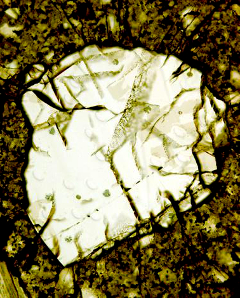Zircon site saved
 A remote patch of WA scrubland has been added to the National Heritage List in order to protect some truly ancient crystals.
A remote patch of WA scrubland has been added to the National Heritage List in order to protect some truly ancient crystals.
Erawondoo Hill, 800 kilometres north of Perth, is home to zircon crystals - the oldest known mineral grains on Earth.
The stones date back an astonishing 4.4 billion years, meaning they formed just 120 million years after the Earth itself.
“This is the most incredible treasure chest in the world,” says Martin van Kranendonk, director of the Australian Centre for Astrobiology at the University of New South Wales.
“It contains little fragments from our planet from just after it was born.”
Professor van Kranendonk says the crystals are located in a “very dry, desolate, and very remote” area, but they are close to mining activity.
Geologists travel from around the world to visit the site.
“The hill looks like nothing particularly special, and if you looked at the rocks and broke them open, you'd say; ‘There's nothing particularly interesting there’, but of course the devil is in the detail,” he said.
“It's moved people to such flights of fancy and thinking about our history, where we came from, what our planet went through to become a habitable environment where we could live.
“It's actually inspired someone to write a symphony about it based on these 4.4-billion-year-old grains.”
Professor van Kranendonk says he is thrilled the site is being protected.
“Nobody could believe it when they first found [out] the age and it's still really hard to come to grips with something that old,” he said.
Federal Environment Minister Sussan Ley says Erawondoo Hill’s outstanding national heritage value has now been officially recognised.
“There is simply nowhere else where zircon crystals this old occur in such abundance,” Minister Ley said in a statement.
“This site has enormous scientific, educational and cultural value which deserves to be recognised and preserved.”
Analysis of the crystals and the surrounding sedimentary rocks have revolutionised scientific thinking about Earth’s early history.
“These crystals not only have information about the time of their formation, they have information about the environment in which they form,” Prof van Kranendonk said.
The crystals formed from magma, or liquid rock, in the crust.
“As it cools, it has very specific compositional information,” he said.
“So it tells us about the nature of the crust that was forming at that time.
“It tells us actually how our planet was cooling, how the first solid material came to be, and that can inform us a lot about where we might think to find life on other planets.”
The same group behind Erawondoo Hill’s listing wants to gain National Heritage recognition for another site in West Australia’s Pilbara - the North Pole Dome, near Port Hedland.
The site contains the oldest evidence of any type of life on Earth, and has been visited by NASA and European Space Agency (ESA) scientists in recent years to help inform the search for signs of life on Mars.








 Print
Print